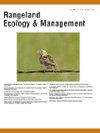Water Quality for Livestock Across Oklahoma and Texas
IF 2.4
3区 环境科学与生态学
Q2 ECOLOGY
引用次数: 0
Abstract
Ponds have been constructed by ranchers in Oklahoma and Texas to offer drinking water to livestock while helping to mitigate the consequences of extreme weather. In this study, the water composition of 72 ponds from ranches in Oklahoma and Texas was surveyed in October and November of 2023, with the objectives to: 1) assess pond water suitability for ruminant livestock consumption, and 2) examine bivariate and multivariate relationships among water quality parameters. Most of the parameters were well below the maximum acceptable upper levels. Even with average values within safe limits, pH, potassium, and manganese concentrations exceeded maximum upper levels in 6.9%, 18.1%, and 15.3% of ponds, respectively. A single pond had an unexpectedly high concentration of cadmium, which placed the average value above the maximum upper limit. Total coliform bacteria (TCB) and Escherichia coli were detected in 95.8% and 55.6% of the samples, respectively, and 39% of the samples exceeded the maximum upper level for TCB. Two major groups of intercorrelated variables identified by the Spearman correlation matrix were confirmed by principal component analysis. Most of the macroconstituents formed one positively intercorrelated group associated with electrical conductivity and total dissolved solids. The second group included several microconstituents that were positively correlated among themselves but negatively correlated with pH. Ensuring animals can access alternative safe water sources within pastures as well as rotating them among pastures throughout the ranch could potentially mitigate health issues when ponds present low-quality water.
俄克拉何马州和德克萨斯州的牲畜水质
俄克拉荷马州和德克萨斯州的牧场主已经建造了池塘,为牲畜提供饮用水,同时帮助减轻极端天气的后果。本研究于2023年10月和11月对俄克拉荷马州和德克萨斯州72个牧场池塘的水组成进行了调查,目的是:1)评估池塘水对反刍牲畜消费的适宜性,2)检验水质参数之间的双变量和多变量关系。大多数参数远低于可接受的最高水平。即使在安全范围内的平均值,6.9%、18.1%和15.3%的池塘的pH、钾和锰浓度也分别超过了最大上限。一个池塘的镉浓度出乎意料地高,使平均值超过了最大上限。总大肠菌群(TCB)和大肠杆菌(Escherichia coli)检出率分别为95.8%和55.6%,其中39%的样品TCB超标。主成分分析证实了Spearman相关矩阵确定的两组主要相关变量。大多数宏观成分形成一个与电导率和总溶解固体相关的正相关基团。第二组包括几种微成分,它们之间呈正相关,但与ph呈负相关。确保动物可以在牧场内获得替代的安全水源,并在整个牧场的牧场之间轮流使用,可能会在池塘出现低质量水时减轻健康问题。
本文章由计算机程序翻译,如有差异,请以英文原文为准。
求助全文
约1分钟内获得全文
求助全文
来源期刊

Rangeland Ecology & Management
农林科学-环境科学
CiteScore
4.60
自引率
13.00%
发文量
87
审稿时长
12-24 weeks
期刊介绍:
Rangeland Ecology & Management publishes all topics-including ecology, management, socioeconomic and policy-pertaining to global rangelands. The journal''s mission is to inform academics, ecosystem managers and policy makers of science-based information to promote sound rangeland stewardship. Author submissions are published in five manuscript categories: original research papers, high-profile forum topics, concept syntheses, as well as research and technical notes.
Rangelands represent approximately 50% of the Earth''s land area and provision multiple ecosystem services for large human populations. This expansive and diverse land area functions as coupled human-ecological systems. Knowledge of both social and biophysical system components and their interactions represent the foundation for informed rangeland stewardship. Rangeland Ecology & Management uniquely integrates information from multiple system components to address current and pending challenges confronting global rangelands.
 求助内容:
求助内容: 应助结果提醒方式:
应助结果提醒方式:


